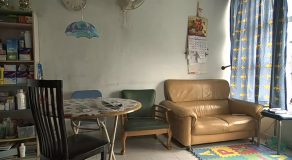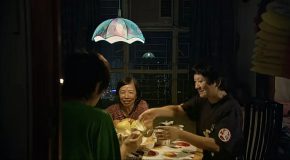Synopsis:
The Way We Are is a film directed by Ann Hui and released in 2008. It illustrates the story of a hardworking, optimistic, widowed mother, her son, and their neighbour Granny, all living in the troubled housing estate of Tin Shui Wai. In our podcast, we discuss the architecture, the shooting techniques and some specific scenes in this film as well as the real Tin Shui Wai.
Script:
B: Hello, everyone. Welcome to our podcast on architecture and film. We’re the hosts today. I’m Beryl.
K: I’m Kira. Today we will talk about the film The Way We Are, directed by Ann Hui and released in 2008. The film tells the tender story of the main character, Kwai, her son Ka-on, and the Granny Leung, who are just neighbours but care about each other like family. Kwai and her son live on each other, while the old lady is lonely and isolated, and their encounter later heals these two broken families at the same time.
1. Introduction of Tin Shui Wai
B: Before we discuss the story in detail, I would like to introduce the film’s background first. It was shot in Tin Shui Wai, a suburb area in the Yuen Long district of Hong Kong’s New Territories, far from Mong Kok and even farther from Central. Along the road in Tin Shui Wai, you can see the whole residential areas where blocks tower up towards the sky. Each block consists of rows of buildings, and all the public housing and private homes, slums and mansions in this area, look the same. People living in public housing here are those at the bottom of the income scale who have lost their security of life and, therefore, whose housing is guaranteed by the government. As a result, some people may think Tin Shui Wai is a place filled with negative press, distinguishing of hope and pure darkness, but the image there shown in this film is totally different. So how do you think it’s presented in the film?

2. Architecture in the film
K: The film shows all the real-life settings of Tin Shui Wai and the residents’ housing, including the interior scenes of the families of Kwai and Granny, which were filmed in two real families found by social workers in Tin Shui Wai.
B: Despite the myriad bright lights of Tin Shui Wai at night, residents there live in poverty day after day. The glowing windows in high density are arranged in neat rows as far as the eyes can see.
The living room can only accommodate a small table and a sofa, and the kitchen aisle is not even big enough for two people to pass through at the same time.

K: In addition to the housing, there are many scenes in the supermarket, which is not only where people buy groceries every day but also the working place for Kwai and Granny. This is where they first meet, and after that, Granny also comes to work here. Each conversation in the supermarket shows that they are getting to know each other better. At the same time, the fact that it is a place where everyone goes makes it even more realistic. Have you thought about how the director illustrated these scenes?
3. Techniques of photography
B: Most of the scenes in homes are shot in fixed positions, making the camera’s presence unnoticeable and capturing the movement of the people in such a way that they appear natural. Meanwhile, many empty shots and long shots are used as well.
K: Exactly. The empty shots mostly show the environment of the Tin Shui Wai community and represent the time and space, and indicate the feelings of the characters. For example, Granny Leung gave all she had into buying gold accessories for her son-in-law’s family as a gift, hoping him to support herself, but refused by the son-in-law. On the way back, Granny Leung sitting in the bus looked at the empty highway stretching infinitely in front of the window, gloomy and sad. This empty shot is used as a metaphor for her future life: lonely and desolate, with nowhere to rest and also nowhere to escape.
On the other hand, long shots take relatively more time to shoot a scene, forming a relatively complete sequence. For example, in the scene at Kwai’s home where the mother and son are eating breakfast and reading the newspaper, a long-fixed shot of fifty-seven seconds gives a real sense of time passing. There is not much useful information in this shot, nor dramatic conflict.
4. Specific scenes
K: I like one scene here without lines the most: Granny Leung walks down the stairs to the market alone to buy food, then goes home to cook and eat. After the meal, she is alone and dazed, waking up in the middle of the night and continuing to stare out of the window. It takes three minutes and a half to present the whole process, and I feel that loneliness and isolation follow her like a shadow. The loss of a loved one and the absence of her son-in-law and grandson are both evident in this long, silent scene. Her small, depressing room and the cramped furniture further reflect this, as here is the only place she belongs to in the vast city.
B: Interestingly, there are thirteen scenes about eating in the film, eight of which take place in Kwai’s home. Granny’s meals show the life of an elderly person living alone in a small space with no expectation of life; Kwai’s meals present the life of a mother and a child in a single-parent family, Ka-on’s good behaviour and understanding reflect the commitment of a child. The fact that Kwai always has a dish made of eggs on her table for five tines echoes the following egg-buying plot and hints at the actual material situation of the family. When the granny uses coins to buy 10 dollars of meat, she tears off the label of a 320-dollar package of mushrooms and gives it to her neighbour Kwai, indicating her generosity, her desire to connect with people, and her hope to have affection. On the mid-autumn night, the three of them eat a reunion dinner together. Ka-on peels grapefruit and gives it to Granny Leung, and they are having a good time. The camera slowly moves from the table to the buildings outside the window, as if to suggest that there are countless families like them, enjoying happiness even in their not-so-generous lives.

The film shows the togetherness of those at the bottom and on the margins of society, whose emotions, connected not by natural blood but by social destiny, consistently sustain the community.
5. Overall structure and conclusion
B: This film presents scenes of trivial daily life, while it has a meticulous and complete narrative structure. Beginning with a set in the early morning when Kwai goes to work, it ends with the union of this reorganized family in the mid-autumn night. Besides the daily life scenes, the three sets of black-and-white photos interspersed among the story all date back to the past, representing the history of different communities in Hong Kong society. At the beginning is a brief history of Tin Shui Wai and the low-income class; in the middle are new women workers in factories as Hong Kong entered the industrial age, and at the end is the community of foreign workers gathering in Victoria’s Park. These pictures show the history of Hong Kong, forming a structural echo among each other and making the film’s narrative quite rhythmic. The past and the present seem to be the same, so we all understand that this is how we – Hong Kong – have come to be.
K: Now, let’s look back at the film’s title. I believe you must have a new understanding of it. The film’s Chinese name is Day and Night in Tin Shui Wai, but it’s translated into The Way We Are. Although the film has a fixed space in Tin Shui Wai from beginning to end, “day and night” simultaneously suggests an eternity with a sense of history.
B: With the clue from pictures in the past, this film is not only about life but also about the transformation of life; not only about the good people but also about the goodness in human nature; not only about Tin Shui Wai but also about Hong Kong. It is precisely the troubled housing conditions of the low-income population that, in contrast, reflect the spirit of optimism and kindness which always exists in Hong Kong people. Therefore, although history has already passed, it’s not The Way We Were but The Way We Are.
K: That’s the end of our podcast today. Thank you for listening!
B: Thank you!
Tan Qianxu 3036097750, Ren Xuan 3036098340
Your well-structured analytical framework smoothly and comprehensively articulates the interweaving of everyday life and architecture in The Way We Are. Lecture 4, especially The Practice of Everyday Life by De Certeau, could largely shed light on your discussion of everyday life and architecture. Besides, I believe you would explore more based on your field trip instead of addicting to the film. Furthermore, I would suggest a slight adjustment in your tone of voice since a more dialogue-liked podcast would greatly enhance the appeal of your work.